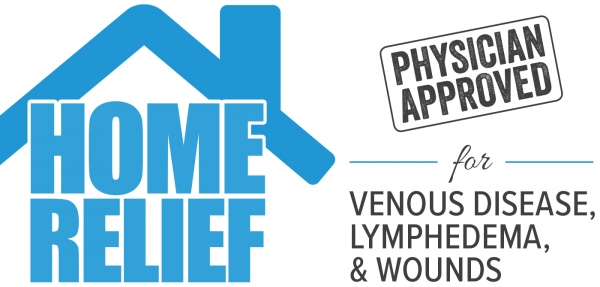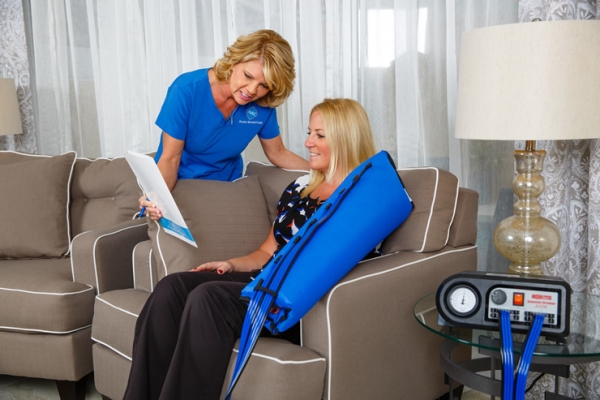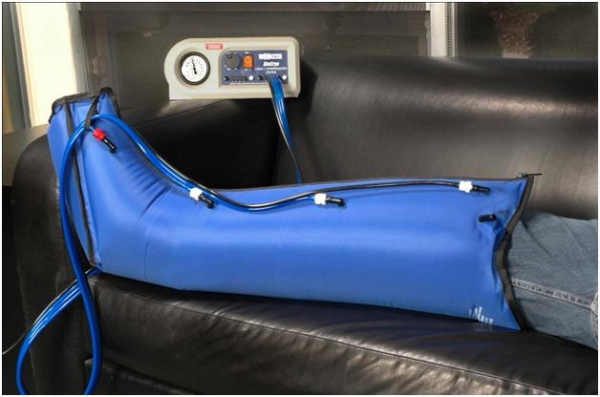
For years, Larry Shanaberger has been getting treatment for his venous insufficiency, a condition in which his veins are unable to efficiently circulate blood from his extremities back to his heart.
Venous Disease & Lymphedema
Circulation problems such as this often result in dermatological problems and lymphedema, a condition in which excess lymph fluid collects in tissues of the legs and/or arms, causing swelling. The swelling can be severe, uncomfortable, making it hard for patients to bend their limbs and complete regular tasks.
In Shanaberger’s case, he was not only suffering from venous disease in his leg but had also developed lymphedema and a recurring ulcer on his ankle.
He says, “The wound would seep to the point that I was changing bandages several times a day.” Shanaberger works in a garden center and is on his feet for hours at a time. A seeping wound on his ankle was not only inconvenient but also challenging to heal.
His Vein Specialist exhausted conservative treatment options with him, so he was referred to Acute Wound Care for in-home compression therapy.

Compression Pumps
Compression pumps are not only used to treat venous insufficiency and ongoing open wounds but are also helpful for patients who have chronic edema, poor circulation, and lymphedema.
The devices have shown great success in boosting circulation and reducing swelling in both the upper and lower extremities. Alyssa Parker, Clinical Administrator at Acute Wound Care says, “Compression pumps have been around for decades. Although many doctors know about their use in hospitals to help with blood clots, many are still unaware that the treatment is available for in-home use as well.”
The pumps consist of long sleeves that fit from the foot to the groin or the hand to the shoulder. They contain multiple chambers that fill with air in a sequential motion, replicating the circulatory system and assisting blood flow from the extremities back to the heart.
Wound Care
The excess fluid in the limbs is worked back through the circulatory system where it can naturally be eliminated by the body. Removing excess fluid might make sense for the reduction of swelling, but how does wound care fit into the picture?
It is hard for wounds to heal when the body has poor circulation. Parker says, “It’s also important to use proper dressings. Individuals trying home remedies to heal a wound without proper dressings are at a higher risk of infection, which may lead to hospitalization.”

Shanaberger says, “They gave me these bandages that helped to absorb moisture from my wound while the pump was working. It was kind of a one-two approach to my healing. The bandages took care of the outside and the pump took care of the inside.” The process helped to dry out his wound in just a couple of weeks.
Parker adds, “I’ve seen cases where patients have been unsuccessfully treating a wound for as long as a year. With the right treatment and specialty dressings, our goal is to get the wound healed within 45 days.”
Quality of Life
Shanaberger uses the compression pump one to two times a day and says, “It makes my leg feel good. It’s kind of like a gentle blood pressure cuff where the pressure builds up then moves from the foot to the thigh, pushing all of that fluid up and out.”
He still uses a topical cream on the wound area and still bandages his foot before going to work to keep it dry but says, “The pump has made a world of difference in the size of my leg and my quality of life.”
The compression pumps are portable so patients can travel with them. A prescription is needed in order to obtain one. Parker says, “Many insurance carriers cover the treatment. The specialists at Acute Wound Care handle the entire process.”
“It was a very easy procedure from the time my doctor made the referral,” says Shanaberger. “Acute Wound Care did all of the insurance work, and they came to my home when it was convenient for me to help me use it.”
He adds, “I see a lot of people walking around with edema on their limbs and I wonder if they know about these pumps. I really want to go up to them and tell them about it. It makes such a difference.”
About Acute Wound Care
Acute Wound Care is family owned and operated by Tom & Alyssa Snyder. Tom is a native to Southwest Florida and Alyssa moved to the area in 1992. Together they have over 16 years of combined experience in Lymphedema, Venous Disease, and Wound Care.

The couple along with their expert staff make it a priority to understand each patient’s unique needs and give them the attention and care that everyone deserves. Their highly educated team has extensive product knowledge. The average heal rate for their patients is just 30-45 days!
Acute Wound Care is an Accredited Medicare provider and accepts most commercial insurance. Their staff guides you through your treatment options and covered benefits. In-home delivery with personalized instruction is also provided.
The Acute Wound Care team looks forward to assisting you and helping expedite the healing process!
You May Like

Combined Modality Treatment of Lymphedema
CLICK HERE to read the full white paper on the modality treatment of Lymphedema using the Reid Sleeve and the BioCompression/Optiflow System

Comparing Different Treatment Options for Lymphedema
Are you currently looking at various options in treating your chronic swelling?CLICK HERE for a detailed whitepaper comparing the Flexitouch System vs. The Bio Compression 3008 System.